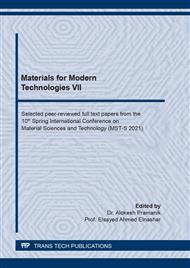[1]
M. K. Rawat, N. Kukreja, S. K. Gupta, Effect of reinforcing micro sized aluminium oxide particles on mechanical properties of polymer based composite Materials Today: Proceedings, (2020).
DOI: 10.1016/j.matpr.2020.02.260
Google Scholar
[2]
Y. Guo, K. Ruan, X. Shi, X. Yang, J. Gu, Factors affecting thermal conductivities of the polymers and polymer composites: A review Composites Science and Technology 193, 108134 (2020).
DOI: 10.1016/j.compscitech.2020.108134
Google Scholar
[3]
A. Sharma, M. Thakur, M. Bhattacharya, T. Mandal, S. Goswami, Commercial application of cellulose nano-composites – A review Biotechnology Reports 21, e00316 (2019).
DOI: 10.1016/j.btre.2019.e00316
Google Scholar
[4]
C. Acquah, M. K. Danquah, C. K. S. Moy, M. Anwar, C. M. Ongkudon, Thermogravimetric characterization of ex situ polymethacrylate (EDMA-co-GMA) monoliths The Canadian Journal of Chemical Engineering 95, 1345-1351 (2017).
DOI: 10.1002/cjce.22781
Google Scholar
[5]
H. Ribeiro et al., Higher thermal conductivity and mechanical enhancements in hybrid 2D polymer nanocomposites Polymer Testing 87, 106510 (2020).
DOI: 10.1016/j.polymertesting.2020.106510
Google Scholar
[6]
M. Asyraf, M. Anwar, L. M. Sheng, M. K. Danquah, Recent Development of Nanomaterial-Doped Conductive Polymers JOM 69, 2515-2523 (2017).
DOI: 10.1007/s11837-017-2628-8
Google Scholar
[7]
R. Scaffaro, L. Botta, in Book, S. Thomas, R. Shanks, S. Chandrasekharakurup, Eds. (William Andrew Publishing, Oxford, 2014), pp.133-160.
Google Scholar
[8]
W. He, P. Song, B. Yu, Z. Fang, H. Wang, Flame retardant polymeric nanocomposites through the combination of nanomaterials and conventional flame retardants Progress in Materials Science 114, 100687 (2020).
DOI: 10.1016/j.pmatsci.2020.100687
Google Scholar
[9]
S. Pourhashem, F. Saba, J. Duan, A. Rashidi, F. Guan, E. G. Nezhad, B. Hou, Polymer/Inorganic nanocomposite coatings with superior corrosion protection performance: A review Journal of Industrial and Engineering Chemistry, (2020).
DOI: 10.1016/j.jiec.2020.04.029
Google Scholar
[10]
J. Jung, H. A. Sodano, High strength epoxy nanocomposites reinforced by epoxy functionalized aramid nanofibers Polymer, 122438 (2020).
DOI: 10.1016/j.polymer.2020.122438
Google Scholar
[11]
S. Khandelwal, K. Y. Rhee, Recent advances in basalt-fiber-reinforced composites: Tailoring the fiber-matrix interface Composites Part B: Engineering 192, 108011 (2020).
DOI: 10.1016/j.compositesb.2020.108011
Google Scholar
[12]
J. George, H. Ishida, A review on the very high nanofiller-content nanocomposites: Their preparation methods and properties with high aspect ratio fillers Progress in Polymer Science 86, 1-39 (2018).
DOI: 10.1016/j.progpolymsci.2018.07.006
Google Scholar
[13]
N. Patel, P. Jain, An investigation on mechanical properties in randomly oriented short natural fiber reinforced composites Materials Today: Proceedings, (2020).
DOI: 10.1016/j.matpr.2020.05.452
Google Scholar
[14]
R. Kumar, A. Anand, Tribological behavior of natural fiber reinforced epoxy based composites: A review Materials Today: Proceedings 18, 3247-3251 (2019).
DOI: 10.1016/j.matpr.2019.07.200
Google Scholar
[15]
V. V. Vasiliev, E. V. Morozov, in Book, V. V. Vasiliev, E. V. Morozov, Eds. (Elsevier, 2018), pp. xvii-xxv.
Google Scholar
[16]
A. Selmi, paper presented at the 2nd International Conference on Emerging Trends in Engineering and Technology (ICETET'2014), May 30-31, 2014 London (United Kingdom), (2014).
DOI: 10.15242/iie.e0514572
Google Scholar
[17]
M. Mehdikhani, L. Gorbatikh, I. Verpoest, S. V. Lomov, Voids in fiber-reinforced polymer composites: A review on their formation, characteristics, and effects on mechanical performance Journal of Composite Materials 53, 1579-1669 (2018).
DOI: 10.1177/0021998318772152
Google Scholar
[18]
Xueshu Liu, F. Chen, A Review of Void Formation and its Effects on theMechanical Performance of Carbon Fiber Reinforced Plastic Engineering Transactions, 33-51 (2016).
Google Scholar
[19]
H. Zhang, R. Ma, D. Luo, W. Xu, Y. Zhao, X. Zhao, Y. Gao, L. Zhang, Understanding the cavitation and crazing behavior in the polymer nanocomposite by tuning shape and size of nanofiller Polymer 188, 122103 (2020).
DOI: 10.1016/j.polymer.2019.122103
Google Scholar
[20]
Y. Gu, M. Li, Z. Zhang, Z. Sun, Void formation model and measuring method of void formation condition during hot pressing process Polymer Composites 31, 1562-1571 (2010).
DOI: 10.1002/pc.20944
Google Scholar
[21]
L. Wu, S. V. Hoa, M.-T. Ton-That, Effects of water on the curing and properties of epoxy adhesive used for bonding FRP composite sheet to concrete Journal of Applied Polymer Science 92, 2261-2268 (2004).
DOI: 10.1002/app.20195
Google Scholar


